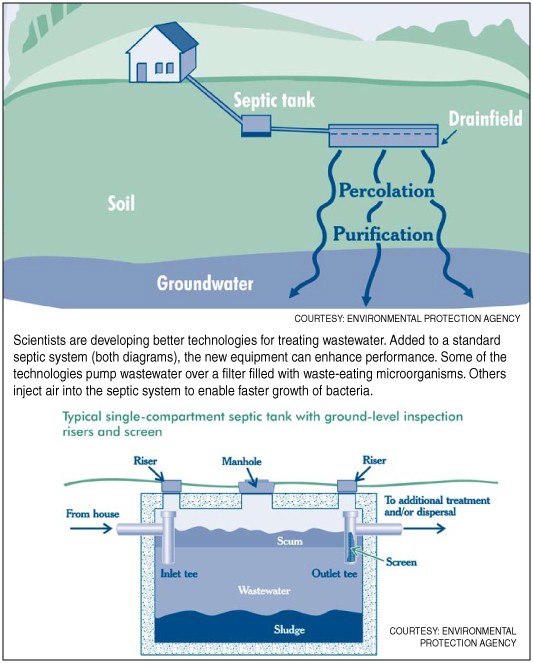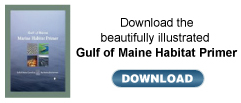Science Insights
Sewage Solutions
By Peter H. Taylor
“What’s that big mound in your yard with the pipe
sticking out of it?” Often that was the first question people
asked as they arrived at my house in a semi-rural town on the
mid-coast of Maine.
“It’s the leach field for my septic system,”
I’d say. Sometimes that was enough of an explanation.
Other times, my guest would pause and say, “What’s
a leach field?”
I had roughly the same level of knowledge—or should I
say ignorance—about septic systems when I bought the house.
A quarter of U.S. residents use septic systems instead of sewers,
but I was a newbie.
I grasped the basic concept that water I flushed down the toilet
or drained from the sink, shower and washing machine would go
into the septic system. Then a series of pipes buried in the “big
mound,” or leach field, would release it into the soil, where
microorganisms would clean up the water. The “pipe sticking
out” of the mound provided ventilation to help the whole
system to work as it should. Beyond that, I didn’t have much
of a clue. It turns out there’s more to it than I ever would
have guessed.
I grew up in a town in suburban Massachusetts where everybody’s
house was hooked up to the town’s sewer system. The moment
we flushed the toilet or drained the sink, the water and its load
of dirt, soap, human waste and food scraps became somebody else’s
problem. That was true everywhere I’d lived as an adult,
too.
Not the case at my new home. I became responsible for making
sure the bad stuff in my wastewater would not seep into groundwater—and
eventually into the ocean inlet by my house. Naïvely, I figured
that since my septic system complied with local regulations and
was well maintained, my wastewater and I were not a source of
pollution.
I actually really liked having a septic system for the same
reason I liked getting water from my well instead of a town water
supply, and burning wood instead of oil to keep warm. It made
me feel self-sufficient and connected to the land, unlike when
I’ve lived in suburban or urban homes. To me, a septic system
seemed more environmentally friendly than a town sewer system.

I didn’t know that even a legally designed, well-maintained
septic system is scarcely better than a sieve for dealing with
some pollutants. Nitrogen is the worst offender. Eighty percent
or more of nitrogen typically escapes untreated through a conventional
septic system. That can add up to 10 pounds (4.5 kilograms) of
nitrogen per year for each person using the system. Once the nitrogen
gets into a lake or bay, it fuels out-of-control growth of algae,
which can foul the water body and compete for nutrients.
The problem is that conventional septic systems lack oxygen.
The persistent scarcity of oxygen prevents the combination of
nitrogen and oxygen atoms into nitrate molecules, which then can
change into nitrogen gas. In its gaseous form, nitrogen is harmless
and does not fuel growth of algae.
It really surprised me that—even in peak operating condition—my
trusty septic system might have contributed to pollution in the
ocean that I enjoyed seeing from my sofa. Most people remotely
familiar with septic systems know that an inadequate or broken
system causes pollution, but the serious shortcomings of “good”
septic systems aren’t as widely known among homeowners and
other regular folk.
Consequently, I was glad to discover recently that scientists
and engineers are conducting research to overcome the technical
shortcomings of conventional septic systems. Already, there are
many options available, such as fixed media (in which the liquid
is pumped over a filter filled with waste-eating microorganisms,
allowing fast treatment in a relatively small space) and suspended-growth
systems (in which a blower injects air into the system to increase
the dissolved oxygen and enable faster growth of bacteria). The
main drawback is that the new technologies tend to cost far more
than a conventional system.
An approach called periodic aeration might emerge as a cheaper
but effective solution. José Amador of the University of
Rhode Island and David Potts of Geomatrix LLC are testing the
approach using a simple, low-cost device that blows air into the
septic system at regular intervals. By injecting oxygen, the device
allows the formation of nitrate. Funded in part by the Cooperative Institute for Coastal and Estuarine
Environmental Technology, the laboratory experiments and field
trials show that periodic aeration can enable a conventional system
to remove up to 75 percent of the nitrogen in wastewater. That’s
a dramatic improvement.
I’m encouraged to know that research is revealing new
ways to make septic systems pollute less. I don’t know yet
if periodic aeration is the best solution for my septic system,
but I’m going to look into it and other promising, new technologies.
Then I’ll really be able to wow my guests with tales about
that “big mound with the pipe sticking out of it.”
Peter H. Taylor (peter@waterviewconsulting.com) is a consultant
for the Gulf of Maine Science Translation Project. He specializes
in communication of coastal and marine science.
|








